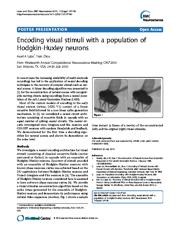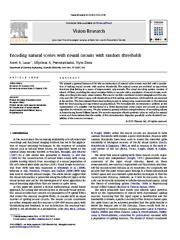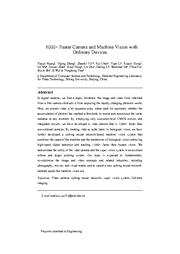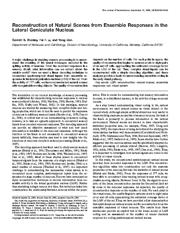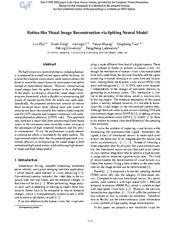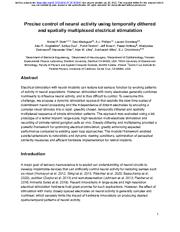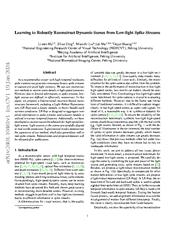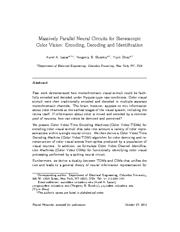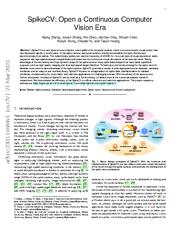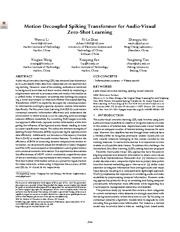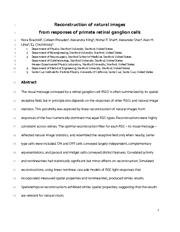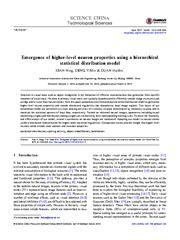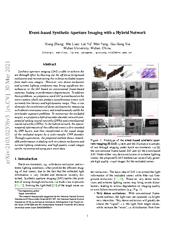A copy of this work was available on the public web and has been preserved in the Wayback Machine. The capture dates from 2020; you can also visit the original URL.
The file type is application/pdf.
Filters
Reconstruction of Natural Visual Scenes from Neural Spikes with Deep Neural Networks
[article]
2020
arXiv
pre-print
Here we fulfill this aim by developing a novel decoding framework based on deep neural networks, named spike-image decoder (SID), for reconstructing natural visual scenes, including static images and dynamic ...
The SID is an end-to-end decoder with one end as neural spikes and the other end as images, which can be trained directly such that visual scenes are reconstructed from spikes in a highly accurate fashion ...
Supplemental Materials: Reconstruction of Natural Visual Scenes from Neural Spikes with Deep Neural Networks Figure S1: Reconstruction from experimental RGC spikes with different loss functions. ...
arXiv:1904.13007v2
fatcat:sxy3usfrrzfmrmmpbhqyahx5uu
Encoding visual stimuli with a population of Hodgkin-Huxley neurons
2010
BMC Neuroscience
We provide a visual stimulus reconstruction algorithm based on the spike times generated by the ensemble of Hodgkin-Huxley neurons and demonstrate its performance using natural video sequences (movies) ...
A linear decoding algorithm was presented in [1] for the reconstruction of natural scenes with recognizable moving objects using recordings from a neural population of the cat's Lateral Geniculate Nucleus ...
We provide a visual stimulus reconstruction algorithm based on the spike times generated by the ensemble of Hodgkin-Huxley neurons and demonstrate its performance using natural video sequences (movies) ...
doi:10.1186/1471-2202-11-s1-p180
pmcid:PMC3090888
fatcat:a5t4hvk4sja6lh2ocqv6bvgm3q
Encoding natural scenes with neural circuits with random thresholds
2010
Vision Research
We present a general framework for the reconstruction of natural video scenes encoded with a population of spiking neural circuits with random thresholds. ...
The natural scenes are modeled as space-time functions that belong to a space of trigonometric polynomials. ...
Givon for configuring the programming environment supporting the implementation of the natural video scenes example, as well as the anonymous reviewers for their comments and suggestions about improving ...
doi:10.1016/j.visres.2010.03.015
pmid:20350565
fatcat:ipgchwdol5dpjcvybykfiqp3jm
1000x Faster Camera and Machine Vision with Ordinary Devices
[article]
2022
arXiv
pre-print
Here, we present vidar, a bit sequence array where each bit represents whether the accumulation of photons has reached a threshold, to record and reconstruct the scene radiance at any moment. ...
Our study is expected to fundamentally revolutionize the image and video concepts and related industries, including photography, movies, and visual media, and to unseal a new spiking neural network-enabled ...
Acknowledgements This work was supported by projects of the National Natural Science Foundation of China (61425025) and the Beijing Municipal Science and Technology Project (Z151100000915070, Z171100000117008 ...
arXiv:2201.09302v1
fatcat:evz4cwvhtffvhkirihljfn3hyq
Reconstruction of Natural Scenes from Ensemble Responses in the Lateral Geniculate Nucleus
1999
Journal of Neuroscience
From the activity of 177 cells, we have reconstructed natural scenes with recognizable moving objects. The quality of reconstruction depends on the number of cells. ...
Here we used a linear decoding technique to reconstruct spatiotemporal visual inputs from ensemble responses in the lateral geniculate nucleus (LGN) of the cat. ...
From the responses of 177 cells, we were able to reconstruct time-varying natural scenes with recognizable moving objects. ...
doi:10.1523/jneurosci.19-18-08036.1999
pmid:10479703
fatcat:pvetxtlf2jgbfadt2h3tsd6hji
Retina-Like Visual Image Reconstruction via Spiking Neural Model
2020
2020 IEEE/CVF Conference on Computer Vision and Pattern Recognition (CVPR)
In this paper, we design a retina-like visual image reconstruction framework, which is flexible in reconstructing full texture of natural scenes from the totally new spike data. ...
However, reconstructing visual images from the spikes remains to be a challenge. ...
This work is partially supported by grants from the National Natural Science Foundation of China under contract No. 61825101 and No. U1611461. ...
doi:10.1109/cvpr42600.2020.00151
dblp:conf/cvpr/ZhuDLHT20
fatcat:udzo4daulrbwhpxobo5lqkclzu
Precise control of neural activity using temporally dithered and spatially multiplexed electrical stimulation
[article]
2022
bioRxiv
pre-print
visual stimulus into a rapid, greedily chosen, temporally dithered and spatially multiplexed sequence of simple stimulation patterns. ...
To overcome this challenge, we propose a dynamic stimulation approach that exploits the slow time scales of downstream neural processing and the independence of distant electrodes by encoding a complex ...
The dynamic stimulus over the array was reconstructed from RGC spikes and the visual scene was then assembled after re-centering each frame of the reconstruction relative to the array. ...
doi:10.1101/2022.07.26.501643
fatcat:papivx3fi5bzjbtc5nso6pch54
Learning to Robustly Reconstruct Low-light Dynamic Scenes from Spike Streams
[article]
2024
arXiv
pre-print
We can use reconstruction methods to restore scene details in high-speed scenarios. However, due to limited information in spike streams, low-light scenes are difficult to effectively reconstruct. ...
Additionally, we have developed a reconstruction benchmark for high-speed low-light scenes. Light sources in the scenes are carefully aligned to real-world conditions. ...
Correspondingly, high-speed dynamic scenes can be reconstructed from spike streams. ...
arXiv:2401.10461v1
fatcat:thlogomy4ff3nl3uksbfuneoua
Massively parallel neural circuits for stereoscopic color vision: Encoding, decoding and identification
2015
Neural Networks
In this space, a signal reconstructed from spike trains generated by the identified neural circuit can be compared to the original stimulus. ...
We provide examples demonstrating that a massively parallel color visual neural circuit can be first identified with arbitrary precision and its spike trains can be subsequently used to reconstruct the ...
Acknowledgements The research reported here was supported by AFOSR under grant #FA9550-12-1-0232 and, in part, by a grant of computer time from the City University of New York HPCC under NSF Grants CNS ...
doi:10.1016/j.neunet.2014.10.014
pmid:25594573
fatcat:x34waa73ojamdodotvg7uuhc3e
SpikeCV: Open a Continuous Computer Vision Era
[article]
2023
arXiv
pre-print
SpikeCV focuses on encapsulation for spike data, standardization for dataset interfaces, modularization for vision tasks, and real-time applications for challenging scenes. ...
As a new type of visual expression, spike sequence has high spatiotemporal completeness and preserves the continuous visual information of the external world. ...
scenes 250 × 400 Spike-REDS [47] Image Synthesized from REDS dataset [25] for reconstruction 720 × 1280 Spike-Vimeo [41] Image Synthesized from Vimeo-90k dataset [42] for super-resolution 256 × 448 Synthetic ...
arXiv:2303.11684v1
fatcat:oxttdwxidzfltebdgf7uknisxu
Motion-Decoupled Spiking Transformer for Audio-Visual Zero-Shot Learning
2023
Proceedings of the 31st ACM International Conference on Multimedia
Audio-visual zero-shot learning (ZSL) has attracted board attention, as it could classify video data from classes that are not observed during training. ...
However, most of the existing methods are restricted to background scene bias and fewer motion details by employing a single-stream network to process scenes and motion information as a unified entity. ...
The label feature reconstruction network reconstructs the label features of novel audio-visual classes. [25] presents a neural network to learn a mapping between audio and visual features extracted from ...
doi:10.1145/3581783.3611759
fatcat:ykdyxvcgjfdupoy6jis4vwj2km
Towards the Next Generation of Retinal Neuroprosthesis: Visual Computation with Spikes
[article]
2020
arXiv
pre-print
Here we review some of the recent progress about visual computation models that use spikes for analyzing natural scenes, including static images and dynamic movies. ...
The retina computes visual scenes and then sends its output as neuronal spikes to the cortex for further computation. Therefore, the neuronal signal of interest for retinal neuroprosthesis is spike. ...
Thus, one can use a decoding model to reconstruct visual scenes from the spiking patterns of the retinal ganglion cells [10, 101] . ...
arXiv:2001.04064v1
fatcat:sqralx5q2zca3k6nvamur46wbe
Reconstruction of natural images from responses of primate retinal ganglion cells
2020
eLife
This possibility was explored by linear reconstruction of natural images from responses of the four numerically-dominant macaque RGC types. Reconstructions were highly consistent across retinas. ...
The optimal reconstruction filter for each RGC – its visual message – reflected natural image statistics, and resembled the receptive field only when nearby, same-type cells were included. ...
This is a known feature of natural scenes (Girshick et al., 2011) , and is 221 present in the images used here ( Figure 3B ).
222 In addition, the visual scene was more uniformly covered by the reconstruction ...
doi:10.7554/elife.58516
pmid:33146609
pmcid:PMC7752138
fatcat:f74r6nlde5bxrjhfzspnojf3km
Emergence of higher-level neuron properties using a hierarchical statistical distribution model
2019
Science China Technological Sciences
Neurons in primary visual cortex are typically hypothesized to efficiently encode image structures such as edge and textures from natural scenes. ...
Essential to visual tasks such as object recognition is the formation of effective representations that generalize from specific instances of visual input. ...
., the dimension N is 100) are randomly extracted from standard grayscale images of natural scenes. 400 excitatory neurons (i.e., J = 400) and 49 inhibitory neurons are set to the dynamic spiking layer ...
doi:10.1007/s11431-018-9327-9
fatcat:4gzlnz3ufzgv3khdojbh5qis4m
Event-based Synthetic Aperture Imaging with a Hybrid Network
[article]
2021
arXiv
pre-print
To reconstruct the occluded targets, we propose a hybrid encoder-decoder network composed of spiking neural networks (SNNs) and convolutional neural networks (CNNs). ...
Synthetic aperture imaging (SAI) is able to achieve the see through effect by blurring out the off-focus foreground occlusions and reconstructing the in-focus occluded targets from multi-view images. ...
Thus the spatiotemporal information is naturally encoded in the spike position and timing. ...
arXiv:2103.02376v3
fatcat:lerztq7twrfhpheb5earcs4fxi
« Previous
Showing results 1 — 15 out of 8,274 results

